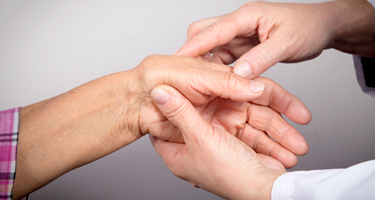Trigger Finger

Many parts of our bodies lose integrity as we age, and inflammation is so often the culprit for this loss of integrity. Arthritis is a disease of inflammation, and it can be debilitating to many. As we get older, our hands often bear the arthritic brunt, as we've been working with our hands our entire lives. One of the hand maladies that sometimes comes with aging is referred to as trigger finger, and it's the topic we'll explore here.
What is trigger finger?
Ever seen someone whose finger is stuck in a bent position? This is a telltale sign they have trigger finger. The finger resembles the trigger of a gun, hence the name. Inflammation is to blame for this deformation, as the tendons of the fingers responsible for flexing the fingers are the inflammatory victim here, causing total restriction of movement.
Risk factors for trigger finger
Some people are more prone to trigger finger than others. If you fall into any of the following categories, you're at a higher risk than others for this debilitating condition:
- You're a senior citizen - As with all forms of arthritis, the aging process is the culprit here. Although, trigger finger can target those in their 40's, too.
- Your job entails repetitive hand motions - Imagine a professional musician, who's constantly strumming their fingers against a guitar string. The strain on the tendon that flexes the finger becomes extreme over time. Farmers are also at risk for trigger finger.
- You have a chronic disease such as diabetes, tuberculosis, rheumatoid arthritis, or hypothyroidism. These chronic diseases put people at risk for developing trigger finger.
Trigger finger signs and symptoms
There are all sorts of telltale signs that point to potentially coming down with a trigger finger. They are:
- Your finger is beginning to feel quite stiff.
- There's a tender feeling around the base of the finger.
- Your finger clicks when you move it.
- A lump is forming around the base of your finger.
- The base of your finger feels sore
What actually causes trigger finger?
The mechanism behind trigger finger is a bit complicated, but what basically comes to pass when trigger finger sets in is a narrowing of the tendon sheath that runs from your forearm to your hand. The sheath is like a tunnel for the long flexor tendon, and when the tunnel narrows, the tendon becomes inflamed. This swelling and inflammation of the tendon causes a restriction of movement for the muscles of the finger. If a lump develops as a result of inflammation, there's even more restriction of movement.
Trigger finger diagnosis
Dr. Eubanks will give you a simple physical exam, take inventory of your medical history, and ask a few questions for a proper diagnosis. Imaging and X-rays aren't typically necessary. After diagnosis, you and Dr. Eubanks will decide upon the best form of treatment for your particular situation.
Trigger finger at-home treatments
Early treatment for trigger finger is best, as the condition can grow more serious with time. If not treated, you may find another finger becomes locked in a bent (or even straight) position. The more fingers impacted, the harder it becomes to do ordinary tasks. For some, trigger finger can be treated at home. Here’s what you can do:
- Rest - There's nothing better than rest when it comes to any form of injury. If you do repetitive movements on a regular basis, take a break. Give yourself a month off and see if there's improvement.
- Wear a splint - Sometimes you need to splint the finger to remind you to rest it. Rest will be inevitable while wearing a splint. If you simply can't wear a splint during the day, try sprinting the finger while you sleep.
- Hot and cold therapy - Icing the finger can help reduce inflammation. A heating pad can also help. Sometimes, alternating between hot and cold is the best option to reduce inflammation at home.
- Stretch the finger - By gently stretching the finger you'll increase its range of motion and potentially prevent a more severe case of trigger finger
- Take over-the-counter medication - Certain over-the-counter medications to reduce inflammation can help. Consider taking the proper dosage of ibuprofen or naproxen.
Steroid injections and prescription meds
Depending upon how advanced the condition has become, Dr. Eubanks may prescribe steroid injections to decrease inflammation and alleviate pain. On the other hand, there are prescription medications that help decrease inflammation and pain that are stronger than the over-the-counter ones. These may also be an option.
Surgery for trigger finger
When trigger finger has progressed, surgery is optimal. It's an outpatient surgery that involves a shot of anesthesia and an incision in the palm of the hand, and then an incision in the sheath of the tendon that's been restricted. The good news is, surgery can be done in the office—no hospital visit necessary. After this simple outpatient surgery, the healing process begins, which allows the entire area to be free of inflammation and restriction, allowing for movement in the finger once again. Sutures are typically removed about a week after surgery.
The healing and recovery process is different for everyone, varying from one month to six months, depending. Expect to receive postoperative homework, a.k.a. hand exercises to help the healing move right along. Some people will be able to return to normal activities with a few days of surgery, while others may need extra time to heal. Proper sleep, diet, and movement helps any and every healing process post surgery to flourish. Self-care is necessary during this time. Treat yourself with love.
Our Surgeon Specializing in Trigger Finger

- Ryan Eubanks, DO
- Hand, Plastic & Reconstructive Surgeon
- Mesa
- Learn More

